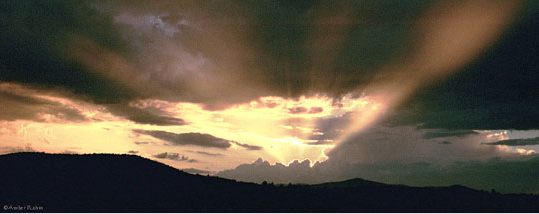Crepuscular rays
Crepuscular Rays: Nature's Spectacular Light Show
Crepuscular rays, also known as sunbeams or God rays, are a mesmerizing atmospheric optical phenomenon that captivates the observer with its ethereal beauty. These rays of sunlight appear to radiate from the position of the sun, streaming through gaps in clouds or other obstacles in the atmosphere. They often create a dramatic display of light and shadow, adding a touch of magic to the sky during sunrise or sunset.
How Crepuscular Rays Form
The formation of crepuscular rays is a result of the scattering of sunlight by particles in the atmosphere, such as dust, water droplets, or ice crystals. When the sun is low on the horizon, its rays have to traverse a longer path through the atmosphere, encountering more particles along the way. This scattering causes the light to disperse and creates the distinct beams that we see.
The Role of Clouds and Obstacles
Clouds play a crucial role in the visibility of crepuscular rays. When the sun is partially obscured by clouds, the rays become more pronounced as they pass through breaks or gaps in the cloud cover. These openings act as natural spotlights, illuminating the surrounding air and creating a stark contrast between the rays and the shaded areas. Similarly, other objects like mountains or buildings can obstruct the sunlight, creating a similar effect when there are gaps or breaks for the rays to shine through.
The Geometry of Crepuscular Rays
The appearance of crepuscular rays can vary depending on the position of the observer and the sun's angle in the sky. When viewed from above, the rays appear to converge towards the antisolar point, which is directly opposite to the sun. This phenomenon occurs due to perspective, as parallel rays of light appear to converge when projected onto a two-dimensional plane. The antisolar point often coincides with the observer's shadow, adding an extra layer of intrigue to the spectacle.
Atmospheric Conditions and Variations
The visibility and intensity of crepuscular rays can be influenced by various atmospheric conditions. The presence of dust or pollution particles in the air can enhance the scattering of light, making the rays more pronounced. Additionally, the size and shape of the particles can affect the appearance of the rays. For example, larger particles tend to produce broader and more diffuse rays, while smaller particles create sharper and more defined beams.
Crepuscular Rays Around the World
Crepuscular rays are a global phenomenon, occurring in different parts of the world under various atmospheric conditions. Whether you find yourself in the mountains, by the coast, or in an urban environment, you have the opportunity to witness this awe-inspiring display of nature's artistry. The specific characteristics of crepuscular rays can vary depending on factors such as latitude, altitude, and local weather patterns, offering a unique experience wherever you may be.
Cultural Significance
Throughout history, crepuscular rays have captured the imagination of humans and inspired countless interpretations in art, literature, and mythology. Many cultures associate these rays with spiritual or divine significance, perceiving them as celestial pathways or messages from the gods. In some traditions, crepuscular rays are seen as a symbol of hope, enlightenment, or transcendence. Regardless of cultural interpretations, these rays continue to evoke a sense of wonder and awe in those who witness their ethereal beauty.
Photographing Crepuscular Rays
Capturing the elusive beauty of crepuscular rays through photography can be a rewarding challenge. To enhance your chances of success, it is essential to consider factors such as the sun's position, cloud cover, and composition. Timing is crucial, as the most striking displays often occur during sunrise or sunset when the sun is near the horizon. Experimenting with different angles, exposure settings, and focal lengths can help you create stunning images that convey the enchantment of crepuscular rays.
Similar Atmospheric Optical Phenomena
While crepuscular rays are undoubtedly captivating, they are just one of many extraordinary atmospheric optical phenomena. Here are a few other notable phenomena that you might encounter:
- Anticrepuscular rays: These rays are the opposite of crepuscular rays, appearing on the opposite side of the sky near the antisolar point.
- Halos: Circular or elliptical rings of light that encircle the sun or moon, caused by the refraction and reflection of light by ice crystals in the atmosphere.
- Rainbows: A beautiful arc of colors caused by the refraction, reflection, and dispersion of sunlight through water droplets in the air.
- Sun pillars: Vertical columns of light that extend above or below the sun, created by the reflection of sunlight off ice crystals in the atmosphere.
Embrace the Magic of Crepuscular Rays
Crepuscular rays are a testament to the breathtaking beauty and complexity of our atmosphere. They remind us of the wonders that surround us and invite us to pause, appreciate, and marvel at the interplay between light, particles, and nature. So, the next time you find yourself bathed in the gentle glow of these radiant beams, take a moment to soak in their splendor and let yourself be transported by their enchanting allure.

Crepuscular rays surge from a setting Vermont sun.
Seen by Amber Rahm on 9th July 2001 with the sun about 2 above the horizon.
Amber Rahm
Note: this article has been automatically converted from the old site and may not appear as intended. You can find the original article here.
Reference Atmospheric Optics
If you use any of the definitions, information, or data presented on Atmospheric Optics, please copy the link or reference below to properly credit us as the reference source. Thank you!
-
<a href="https://atoptics.co.uk/blog/crepuscular-rays-7/">Crepuscular rays </a>
-
"Crepuscular rays ". Atmospheric Optics. Accessed on November 26, 2024. https://atoptics.co.uk/blog/crepuscular-rays-7/.
-
"Crepuscular rays ". Atmospheric Optics, https://atoptics.co.uk/blog/crepuscular-rays-7/. Accessed 26 November, 2024
-
Crepuscular rays . Atmospheric Optics. Retrieved from https://atoptics.co.uk/blog/crepuscular-rays-7/.